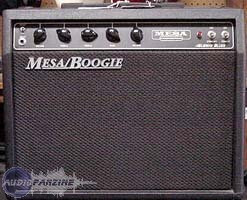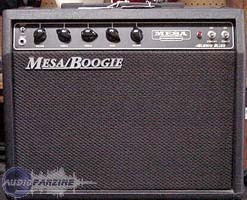View other reviews for this product:
« I love this amp »
Published on 11/11/10 at 03:42Several models exist.
There are 20 or 25w (the very first, rare) and the hp is not always a Mesa Boogie Black Shadow (general case, however). In addition, there are those with or without reverb, those with a guitar input and inter bright / fat, those with 2 inputs guitar but without the cross (the 2 inputs play this role) and those with or without output 1 / 2 power for the hp.
Mine is the model with inter, reverb and output 1 / 2 power, hp Mesa Black Shadow 10 ". It dates from 2001.
The effects loop is a "parallel range. This means that only part of the guitar signal not the power (the other party directly involved in the amp). A knob dose the percentage who pass through this loop. At bottom, the loop behaves like a loop-type "serial" (the entire guitar signal passes through the loop). The advantage of such "parallel range" is that if your effect is not very respectful of your guitar sound your final sound will remain good.
Another peculiarity, no adjustment of bias is necessary. The manual devotes a large part, explaining that this setting is factory unnecessary. I changed my game 6 times lamps, sometimes staying at Mesa Boogie, sometimes by testing other brands, I never had the slightest concern.
UTILIZATION
I play mainly jazz and blues, and I do a lot of studio.La configuration is simple. Yet, as always with Mesa Boogie, interdependence settings can be confusing at first. Already, the volume knob will have a big influence. I do not speak of his or light but velvety crunch / soft / aggression. Then comes the treble knob. Again its operation may be surprising because the more one rises less those of middle and bass have influence to do more and have at all when the treble is at 3 / 4. The middle button, meanwhile, does not work as such until the 11h position. At zero we obtain a special round (my favorite position with my jazz box) the higher you go the more the sound hardens (great for rock). Beyond it behaves like a presence or as an additional gain, depending on the position of the volume button. That bass has a normal behavior as the highs do not exceed 3 / 4 position because in this case, it is totally ineffective! Reverb, for its part, allows subtle nuances really but will never give the effect that allows a Twin Cathedral Reberb, for example. She rounds the sound. However, with the reverb to zero, we get a great jazz or rock his style 1950.
The inter bright / fat influences "aggressiveness" of the amp. The position will give bright softness to the sound. That of fat will be more rock (especially with a stratovolcano or a telecaster).
That, in my opinion, a little amp that will please fans of "I connect, I play" on the other hand, those who like spending time to concoct a great sound will not be disappointed because this is not a but they will find a host, especially if they have several guitars.
SOUNDS
In fact, the sound of the amp will deeply depend on the time you spend on it. This can range from abysmal to the sublime, depending on whether you know what you are looking for and how to find it. I've had almost 10 years, I use every day (stage, studio, home) and yet I can not get enough.
Another advantage of this amp: a cross gives the possibility to cut the hp. We can then use the output of which the sound recording is really excellent because of its good speaker simulation (practice at 3 am, when mum and baby sleeping in the next room and it is imperative that damn solo work tomorrow ... yeah, it feels lived !!!).
OVERALL OPINION
As stated above, I since 2001. Before I had a Fender Super Reverb, a Fender Twin Reverb, a Fender 59 Bassman RI. All had one or more drawbacks. The weight, size, power too much, etc. ... Speaking in the studio I saw pass a myriad of amps of all makes, few are gathered all the benefits of Subway Blues, namely:
- Extraordinary quality of sound when you know the deal (if the majority of Boogie)
- Adaptability / versatility as it does not do metal,
- Easy transport (weight, size)
- Loop can be changed from "series" to "PARALLEL" through use of a knob,
- Full and half power outputs, and additional hp and 8ohm 1 x 2 x 4ohms,
- Possibility to cut the cramer hp without the amp,
- Relamping without bias adjustment, therefore, without intervention of a technician and immobilization of the amp, just do it yourself.
As for the blast (noise) is talking about the poster PREV I'm surprised. Of course, like any tube amp, it is noisier than a transistor amp. But to say that the noise makes use of the amp can not ... If this were the case, I'm not a studio (where silence is golden) and I'll never kept this material so long.
My only regret is that he has no choice of class A or AB as some Boogie.
The Subway Blues is not a boogie at a discount. Mesa Boogie understood before anyone else that all the guitarists did not need a cabinet Norman 100w to exist on stage, let alone in the studio! 20w is sufficient in 95% of situations (I know something) and pushed to 3 / 4 volume quickly cause a riot in your building ...
Alas, the amp has been discontinued since long and opportunities are relatively rare. on the other hand discount it too quickly. I paid my own (new) 950 € in 2001 and it sells, in general, around 700 € as specified in the header of this page.
There are 20 or 25w (the very first, rare) and the hp is not always a Mesa Boogie Black Shadow (general case, however). In addition, there are those with or without reverb, those with a guitar input and inter bright / fat, those with 2 inputs guitar but without the cross (the 2 inputs play this role) and those with or without output 1 / 2 power for the hp.
Mine is the model with inter, reverb and output 1 / 2 power, hp Mesa Black Shadow 10 ". It dates from 2001.
The effects loop is a "parallel range. This means that only part of the guitar signal not the power (the other party directly involved in the amp). A knob dose the percentage who pass through this loop. At bottom, the loop behaves like a loop-type "serial" (the entire guitar signal passes through the loop). The advantage of such "parallel range" is that if your effect is not very respectful of your guitar sound your final sound will remain good.
Another peculiarity, no adjustment of bias is necessary. The manual devotes a large part, explaining that this setting is factory unnecessary. I changed my game 6 times lamps, sometimes staying at Mesa Boogie, sometimes by testing other brands, I never had the slightest concern.
UTILIZATION
I play mainly jazz and blues, and I do a lot of studio.La configuration is simple. Yet, as always with Mesa Boogie, interdependence settings can be confusing at first. Already, the volume knob will have a big influence. I do not speak of his or light but velvety crunch / soft / aggression. Then comes the treble knob. Again its operation may be surprising because the more one rises less those of middle and bass have influence to do more and have at all when the treble is at 3 / 4. The middle button, meanwhile, does not work as such until the 11h position. At zero we obtain a special round (my favorite position with my jazz box) the higher you go the more the sound hardens (great for rock). Beyond it behaves like a presence or as an additional gain, depending on the position of the volume button. That bass has a normal behavior as the highs do not exceed 3 / 4 position because in this case, it is totally ineffective! Reverb, for its part, allows subtle nuances really but will never give the effect that allows a Twin Cathedral Reberb, for example. She rounds the sound. However, with the reverb to zero, we get a great jazz or rock his style 1950.
The inter bright / fat influences "aggressiveness" of the amp. The position will give bright softness to the sound. That of fat will be more rock (especially with a stratovolcano or a telecaster).
That, in my opinion, a little amp that will please fans of "I connect, I play" on the other hand, those who like spending time to concoct a great sound will not be disappointed because this is not a but they will find a host, especially if they have several guitars.
SOUNDS
In fact, the sound of the amp will deeply depend on the time you spend on it. This can range from abysmal to the sublime, depending on whether you know what you are looking for and how to find it. I've had almost 10 years, I use every day (stage, studio, home) and yet I can not get enough.
Another advantage of this amp: a cross gives the possibility to cut the hp. We can then use the output of which the sound recording is really excellent because of its good speaker simulation (practice at 3 am, when mum and baby sleeping in the next room and it is imperative that damn solo work tomorrow ... yeah, it feels lived !!!).
OVERALL OPINION
As stated above, I since 2001. Before I had a Fender Super Reverb, a Fender Twin Reverb, a Fender 59 Bassman RI. All had one or more drawbacks. The weight, size, power too much, etc. ... Speaking in the studio I saw pass a myriad of amps of all makes, few are gathered all the benefits of Subway Blues, namely:
- Extraordinary quality of sound when you know the deal (if the majority of Boogie)
- Adaptability / versatility as it does not do metal,
- Easy transport (weight, size)
- Loop can be changed from "series" to "PARALLEL" through use of a knob,
- Full and half power outputs, and additional hp and 8ohm 1 x 2 x 4ohms,
- Possibility to cut the cramer hp without the amp,
- Relamping without bias adjustment, therefore, without intervention of a technician and immobilization of the amp, just do it yourself.
As for the blast (noise) is talking about the poster PREV I'm surprised. Of course, like any tube amp, it is noisier than a transistor amp. But to say that the noise makes use of the amp can not ... If this were the case, I'm not a studio (where silence is golden) and I'll never kept this material so long.
My only regret is that he has no choice of class A or AB as some Boogie.
The Subway Blues is not a boogie at a discount. Mesa Boogie understood before anyone else that all the guitarists did not need a cabinet Norman 100w to exist on stage, let alone in the studio! 20w is sufficient in 95% of situations (I know something) and pushed to 3 / 4 volume quickly cause a riot in your building ...
Alas, the amp has been discontinued since long and opportunities are relatively rare. on the other hand discount it too quickly. I paid my own (new) 950 € in 2001 and it sells, in general, around 700 € as specified in the header of this page.



